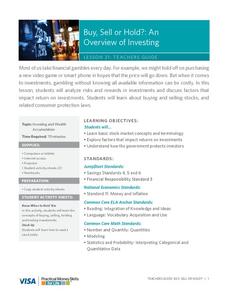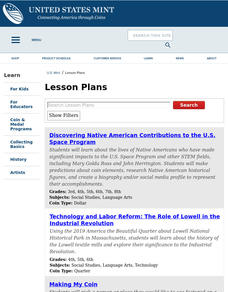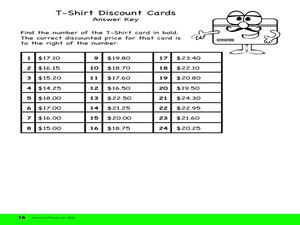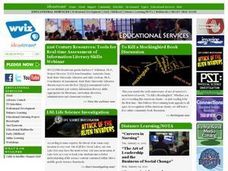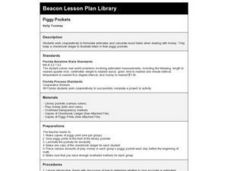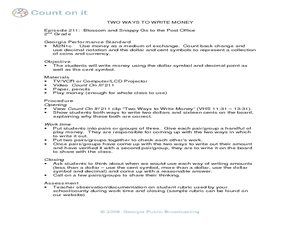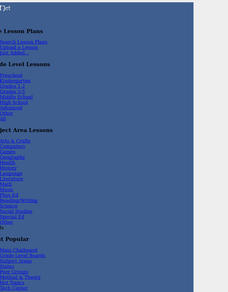Curated OER
Walk-a-thon
Fifth graders solve word problems. In this math lesson, 5th graders read the word problem and determine what is being asked. Students solve the problem and explain how they reached their solution.
EngageNY
Interpreting the Graph of a Function
Groups sort through NASA data provided in a graphic to create a graph using uniform units and intervals. Individuals then make connections to the increasing, decreasing, and constant intervals of the graph and relate these connections...
Federal Reserve Bank
Financial Goals
Do you have financial goals? How will you make them happen? Help your pupils answer these questions through this interactive project. They create goals and a plan for reaching them as one of many high school algebra projects.
EngageNY
Linear Functions and Proportionality
Connect linear equations, proportionality, and constant rates of change to linear functions. Young mathematicians learn how linear equations of the form y = mx + b can represent linear functions. They then explore examples of linear...
EngageNY
Conducting a Simulation to Estimate the Probability of an Event II
Add some randomization into simulations. The 11th installment in a series of 25 presents two new methods to use in simulations--colored disks, and random numbers. Pupils use random numbers to run simulations where the probabilities make...
EngageNY
Conducting a Simulation to Estimate the Probability of an Event
How can you complete a simulation when it is not practical to determine the probability of an event? Class members learn that in some situations, it is not feasible to find the probability of an event, but they can estimate it by running...
Visa
Buy, Sell or Hold?: An Overview of Investing
Break down the often-daunting topic of the stock market with this resource, in which pupils learn basic terminology regarding buying and selling stocks, as well as the factors that influence how much return individuals can receive on...
Henrico County Public Schools
Models for Teaching Addition and Subtraction of Integers
Positive and negative numbers are everywhere in the world around us. Whether it's charged particles in atoms, a hot air balloon rising and falling in the sky, or a series of bills and checks being delivered in the mail, this resource...
National Council of Teachers of Mathematics
The Game of SKUNK
Do I stand or do I sit? The class plays a dice game where they must decide to either continue to stand and play or sit down and keep their points. After the game, groups discuss individuals' strategies and see connections to the...
Curated OER
How Much Will That House Cost?
What is a mortgage and how do you use it to pay for a house? Young financiers determine how much money is actually spent paying a mortgage payment on a home. They use their math skills to calculate monthly payments on a home given a 30...
Curated OER
Completing Simple Tax Forms
Twelfth graders practice filling out IRS 1040 EZ forms. They discuss various ways people pay taxes. They assess the importance of W-2 forms and apply skills using the IRS tax table to compute how much money is owed or returned.
Curated OER
Converting Fractions to Decimals
Seventh graders take a simple fraction and give it decimal form either by the use of equivalent fractions or division with a calculator.
Curated OER
The Many Faces of Coins
Students examine and discuss the designs on the circulating coins produced by the United States Mint. They read about the woman and child featured on the Golden Dollar. They compare and contrast coins using a Venn Diagram.
Curated OER
Trading Game
Students listen to story about money or coins, and play game to help them solidify their understanding of money. Students focus specifically on coin value and calculating amounts of money up to fifty cents or above, depending on level.
Curated OER
Wise Shoppers
Students complete several activities to learn about currency and the functions of money. For this money functions lesson, students complete activities to learn what are the functions of money. Students calculate item prices with...
Curated OER
Tzedakah: How Can We Help?
Young scholars define what constitutes a nutritious meal, the price of a healthy meal, and understand that some people can't afford healthy meals. In this healthy meals instructional activity, students estimate and research the cost of a...
Curated OER
Chances Are...
Students examine the probability of an event. In this probability lesson, students determine whether it is likely that an event will occur in coin flipping activities. They work with two and four coins, and one die in three different...
Curated OER
Lemonade Stand: Making Money the Old-Fashioned Way
Students run their own lemonade stand and are to figure out what to sell the lemonade at to gain the maximum profit.
Curated OER
Piggy Pockets
Second graders determine when estimates and exact totals are appropriate in dealing with money. They simulate keeping a checking account over a period of time and keep a checkbook ledger to record deposits and expenses.
Curated OER
Money
Second graders show combinations for $1.00. In this dollar combinations instructional activity, 2nd graders use nickels, dimes, and quarters to model and count combinations equaling $1.00.
Curated OER
Money Matters
Students explore the concept of money. In this money lesson plan, students role play an economy. Students are divided into three categories- the money factory, construction workers, and the grocery store. Students work cooperatively to...
Curated OER
Two Ways to Write Money
Second graders complete activities to learn about money and how to write money. In this money lesson, 2nd graders watch a video about ways to write money. Students work in groups with play money and come up with two ways to write money....
Curated OER
Money Talks
Students move from fact finding to interpretation as they examine paper money from the time of the American Revolution. In the final exercise, they use the issue dates of the bills to construct a chronology of political changes during...
Curated OER
Spelling Payment (Elementary, Mathematics)
Students practice spelling words and earn points (Each spelling word is assigned a value.) for each one spelled correctly. They keep track of money earned and may purchase items at the end of the month.








